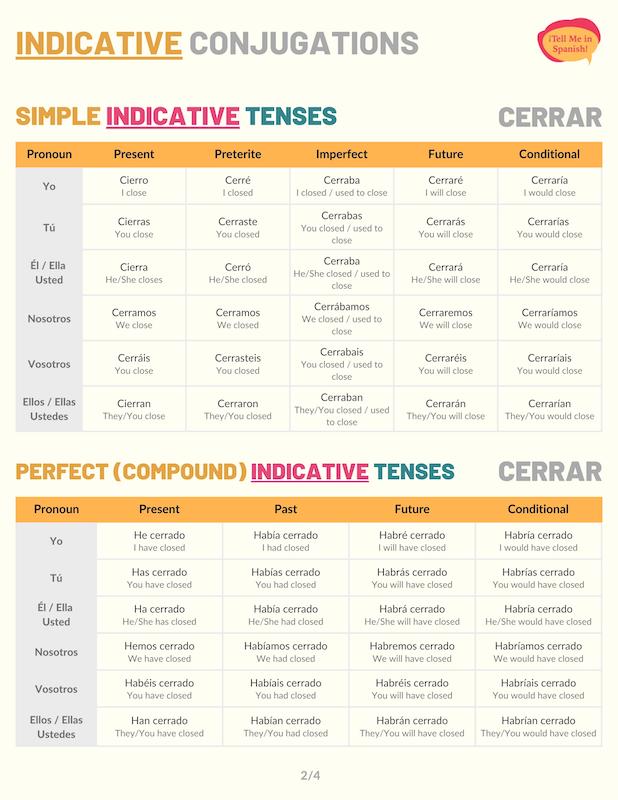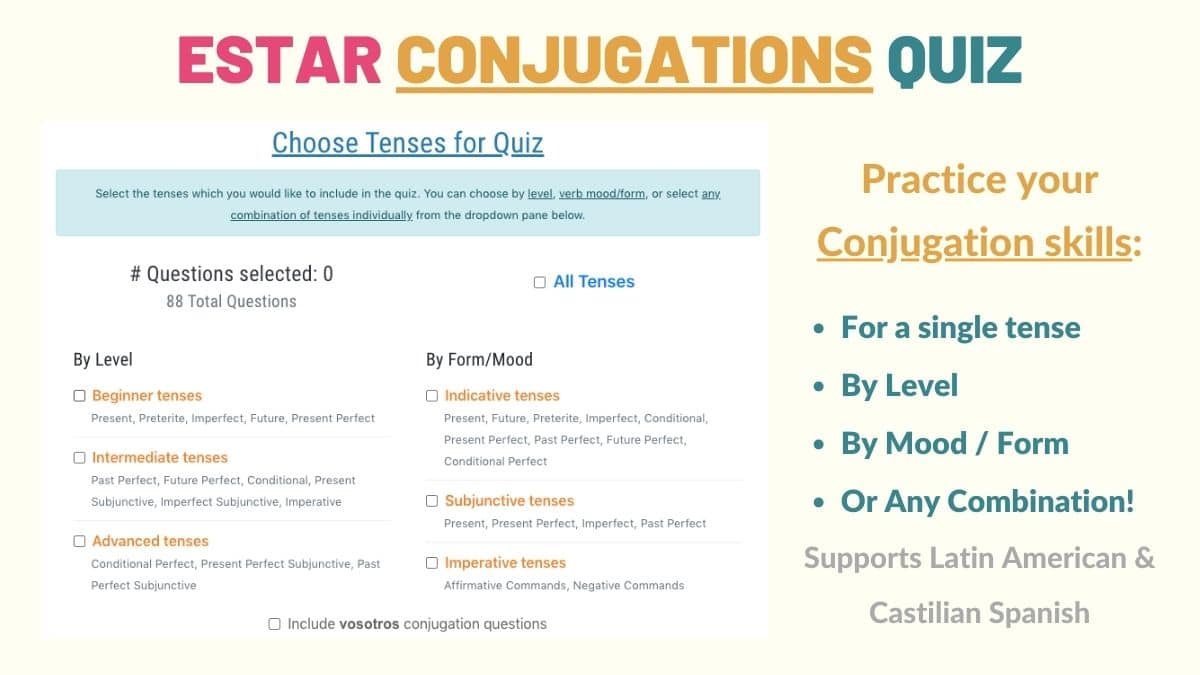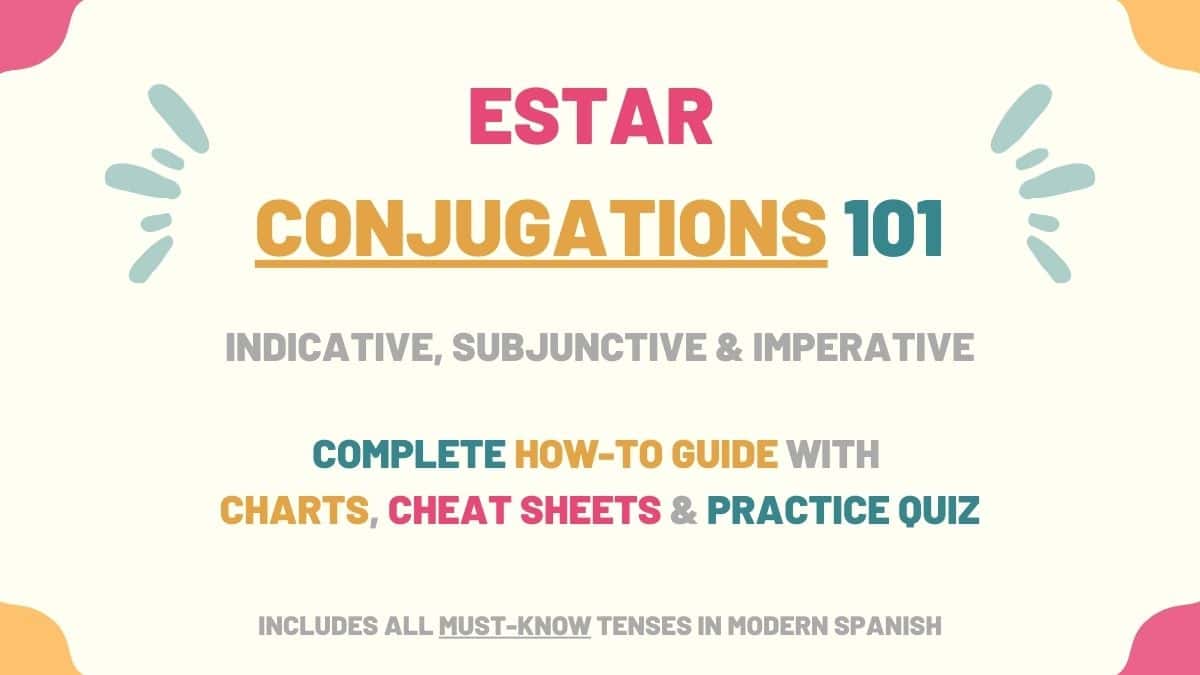As you may already know, regardless of your level of Spanish, estar is a verb you’ll use in all your Spanish conversations. Since this is such a crucial verb, in the following sections, we’ll go through the most important estar conjugations charts. Here is a quick summary of what you’ll learn.
- Estar Overview
- Indicative Tenses of Estar Conjugations
- Subjunctive Tenses of Estar Conjugations
- Imperative (Commands) of Estar Conjugations
- Uses & Examples
- Download Estar Conjugation Tables & Uses Cheat sheets
- Estar Conjugation Practice Quiz
Overview of Estar
| Verb Characteristic | Property |
|---|---|
| Verb Type | -AR |
| Irregular | Yes |
| Infinitive | Estar |
| Gerund (Present Participle) Form | Estando |
| Past Participle Form | Estado |
| Synonyms | Andar |
Irregularities:
- Present tense: estoy (only ‘yo’).
- Preterite: estuv for all subject pronouns.
- Imperfect subjunctive: estuv for all subject pronouns except ‘vosotros’.
Take Note: Estar does not have progressive tenses since it’s the auxiliary verb we use to form these tenses. Therefore, you will not find any conjugations in the progressive/continuous tenses as they do not exist for this or other auxiliary verbs. Rather, it is used to build the progressive tenses!
Indicative Conjugations of Estar
Present tense
In the present tense, the yo conjugation of ‘estar’ is irregular. In this tense, estar can be used to express location or to describe physical or emotional states. For example: Los niños están en su cuarto.
| Person | Conjugation | Translation |
|---|---|---|
| Yo | Estoy | I am |
| Tú | Estás | You are |
| Él / Ella Usted | Está | He/She is You (formal) are |
| Nosotros | Estamos | We are |
| Vosotros | Estáis | You are |
| Ellos / Ellas Ustedes | Están | They are You (plural) are |
Preterite tense
All estar preterite conjugations are irregular. To form this tense, we must use the stem estuv-. In the preterite tense, ‘estar’ allows you to express location or describe the state of something at a specific moment in time. El año pasado, estuve muy enfermo.
| Person | Conjugation | Translation |
|---|---|---|
| Yo | Estuve | I was |
| Tú | Estuviste | You were |
| Él / Ella Usted | Estuvo | He/She was You (formal) were |
| Nosotros | Estuvimos | We were |
| Vosotros | Estuvisteis | You were |
| Ellos / Ellas Ustedes | Estuvieron | They were You (plural) were |
Imperfect tense
In the past imperfect tense, estar is a regular verb. With this tense, ‘estar’ allows you to describe the location or state of something or someone at an unspecified moment in the past. El cine estaba atrás de la farmacia.
| Person | Conjugation | Translation |
|---|---|---|
| Yo | Estaba | I was I used to be |
| Tú | Estabas | You were You used to be |
| Él / Ella Usted | Estaba | He/She was He/She used to be You (formal) were You (formal) used to be |
| Nosotros | Estábamos | We were We used to be |
| Vosotros | Estabais | You were You used to be |
| Ellos / Ellas Ustedes | Estaban | They were They used to be You (plural) were You (plural) used to be |
Near future
We use estar in the near future form to communicate the location or physical/emotional state of something in the immediate future. For example: Esta semana vamos a estar muy ocupados. This tense is formed with ir (present) + a + estar and can be translated as “going to be”.
| Person | Conjugation | Translation |
|---|---|---|
| Yo | Voy a estar | I’m going to be |
| Tú | Vas a estar | You’re going to be |
| Él / Ella Usted | Va a estar | He/She is going to be You (formal) are going to be |
| Nosotros | Vamos a estar | We’re going to be |
| Vosotros | Vais a estar | You’re going to be |
| Ellos / Ellas Ustedes | Van a estar | They’re going to be You (plural) are going to be |
Future simple tense
The future conjugations of ‘estar’ communicate the future location or state of someone or something. For instance: Lilly estará ahí a las 11. ‘Estar’ is a regular verb in the future tense.
| Person | Conjugation | Translation |
|---|---|---|
| Yo | Estaré | I will be |
| Tú | Estarás | You will be |
| Él / Ella Usted | Estará | He/She will be You (formal) will be |
| Nosotros | Estaremos | We will be |
| Vosotros | Estaréis | You (formal) will be |
| Ellos / Ellas Ustedes | Estarán | They will be You (plural) will be |
Conditional tense
The conditional forms of estar express what the location or physical state of something would be if a given circumstance was fulfilled. Here is an example: si pudiera, estaría descansando en mi casa.
| Person | Conjugation | Translation |
|---|---|---|
| Yo | Estaría | I would be |
| Tú | Estarías | You would be |
| Él / Ella Usted | Estaría | He/She would be You (formal) would be |
| Nosotros | Estaríamos | We would be |
| Vosotros | Estaríais | You would be |
| Ellos / Ellas Ustedes | Estarían | They would be You (plural) would be |
Present perfect tense
You can use the present perfect forms of ‘estar’ to explain the places where you have been or the feelings you have experienced. ¿Has estado en París? With this verb, the formula for the present perfect in Spanish is: ‘haber’ (present tense) + estado.
| Person | Conjugation | Translation |
|---|---|---|
| Yo | He estado | I have been |
| Tú | Has estado | You have been |
| Él / Ella Usted | Ha estado | He/She has been You (formal) have been |
| Nosotros | Hemos estado | We have been |
| Vosotros | Habéis estado | You have been |
| Ellos / Ellas Ustedes | Han estado | They have been You (plural) have been |
Past perfect
The Spanish past perfect of ‘estar’ describes the location or physical/emotional state of something before some other reference point in the past. No sabía que habías estado en París. To conjugate this tense, use the formula haber (imperfect form) + estado (estar’s past participle form).
| Person | Conjugation | Translation |
|---|---|---|
| Yo | Había estado | I had been |
| Tú | Habías estado | You had been |
| Él / Ella Usted | Había estado | He/She had been You (formal) had been |
| Nosotros | Habíamos estado | We had been |
| Vosotros | Habíais estado | You had been |
| Ellos / Ellas Ustedes | Habían estado | They had been You (plural) had been |
Future perfect
Estar’s future perfect conjugations are formed by conjugating haber to the future tense and adding estado (the past participle of ‘estar’). In this tense, ‘estar’ communicates that someone will be somewhere or feel a certain way by or before a certain time in the future. For example: Antes de abril, habré estado en tres continentes
| Person | Conjugation | Translation |
|---|---|---|
| Yo | Habré estado | I will have been |
| Tú | Habrás estado | You will have been |
| Él / Ella Usted | Habrá estado | He/She will have been You (formal) will have been |
| Nosotros | Habremos estado | We will have been |
| Vosotros | Habréis estado | You will have been |
| Ellos / Ellas Ustedes | Habrán estado | They will have been You (plural) will have been |
Conditional perfect
The conditional perfect of ‘estar’ can be used to express that someone would have been in a certain place or state if a past condition had been met. For instance, habría estado mejor que me dijeras.
| Person | Conjugation | Translation |
|---|---|---|
| Yo | Habría estado | I would have been |
| Tú | Habrías estado | You would have been |
| Él / Ella Usted | Habría estado | He/She would have been You (formal) would have been |
| Nosotros | Habríamos estado | We would have been |
| Vosotros | Habríais estado | You would have been |
| Ellos / Ellas Ustedes | Habrían estado | They would have been You (plural) would have been |
Estar Subjunctive Conjugations
In Spanish, the subjunctive is used to talk about wishes, hypothetical situations or express uncertainty. The conjugation charts below show the subjunctive forms of estar.
Present subjunctive
Estar’s present subjunctive conjugations refers to wishes, suggestions and expectations about the place or mood in which you want someone or something to be. For instance: Ojalá el restaurante no esté lleno. Notice that some of the present subjunctive conjugations of ‘estar’ have an accent mark.
| Person | Conjugation | Translation |
|---|---|---|
| Yo | Esté | I am |
| Tú | Estés | You are |
| Él / Ella Usted | Esté | He/She is You (formal) are |
| Nosotros | Estemos | We are |
| Vosotros | Estéis | You are |
| Ellos / Ellas Ustedes | Estén | They are You (plural) are |
Present perfect subjunctive
Haber in the present subjunctive + estado is the structure you must use to build the present perfect subjunctive form of ‘estar’. Use ‘estar’ in this tense to convey uncertainty about the location or state of something or someone. ¿Quién crees que haya estado con Julia?
| Person | Conjugation | Translation |
|---|---|---|
| Yo | Haya estado | I have been |
| Tú | Hayas estado | You have been |
| Él / Ella Usted | Haya estado | He/She has been You (formal) have been |
| Nosotros | Hayamos estado | We have been |
| Vosotros | Hayáis estado | You have been |
| Ellos / Ellas Ustedes | Hayan estado | They have been You (plural) have been |
Imperfect subjunctive
The imperfect subjunctive of ‘estar’ can be used to build past conditions related to something or someone’s physical or emotional state. For example: Si estuviera enojada, no habría venido. These subjunctive forms of ‘estar’ are irregular and are formed with the stem estuv-.
The imperfect subjunctive has two conjugation models depending on which type of Spanish you’re using:
Latin American Spanish version
Keep in mind that the table below does not contain a conjugation for vosotros since this pronoun is not used in Latin American Spanish.
| Person | Conjugation | Translation |
|---|---|---|
| Yo | Estuviera | I were |
| Tú | Estuvieras | You were |
| Él / Ella Usted | Estuviera | He/She were You (formal) were |
| Nosotros | Estuviéramos | We were |
| Ellos / Ellas Ustedes | Estuvieran | They were You (plural) were |
Castilian Spanish version
| Person | Conjugation | Translation |
|---|---|---|
| Yo | Estuviese | I were |
| Tú | Estuvieses | You were |
| Él / Ella Usted | Estuviese | He/She were You (formal) were |
| Nosotros | Estuviésemos | We were |
| Vosotros | Estuvieseis | You were |
| Ellos / Ellas Ustedes | Estuviesen | They were You (plural) were |
Past perfect subjunctive
In the past perfect subjunctive, estar refers to the place or condition in which something would have been if a past circumstance was met. Habría estado más lleno, si hubieran vendido todos los boletos.
| Person | Conjugation | Translation |
|---|---|---|
| Yo | Hubiera estado | I had been |
| Tú | Hubieras estado | You had been |
| Él / Ella Usted | Hubiera estado | He/She had been You (formal) had been |
| Nosotros | Hubiéramos estado | We had been |
| Vosotros | Hubierais estado | You had been |
| Ellos / Ellas Ustedes | Hubieran estado | They had been You (plural) had been |
Estar Imperative Conjugations
The Spanish imperative mood is used to instruct people on what to do (affirmative imperative) and what not to do (negative imperative).
Affirmative commands
The affirmative commands of estar are frequently used to instruct people to be in a certain state or condition. For example: estad preparados.
| Person | Conjugation | Translation |
|---|---|---|
| Tú | Está | Be |
| Usted | Esté | Be |
| Vosotros | Estad | Be |
| Ustedes | Estén | Be |
Negative commands
The negative imperative of ‘estar’ can be used to request someone to stop feeling a certain way. For example: no estés triste, todo va a estar bien.
| Person | Conjugation | Translation |
|---|---|---|
| Tú | No estés | Don’t be |
| Usted | No esté | Don’t be |
| Vosotros | No estéis | Don’t be |
| Ustedes | No estén | Don’t be |
Meanings of Estar & Examples
Since you’ve now learned how to conjugate ‘estar’ in Spanish, you should learn how to use this verb in the many contexts and situations in which it can be used. The most common meanings and uses of ‘estar’ are:
- Talk about something or someone’s location
[Estar conjugated] + [complement]
Tus llaves están aquí.
Your keys are here.
No creo que Juan esté en la oficina.
I don’t think Juan is at the office.
- Auxiliary verb in progressive tenses
[Estar conjugated ] + [present participle verb]
Ayer estuve revisando tu proyecto.
Yesterday, I was reviewing your project.
Estaremos aterrizando en unos minutos.
We will be landing in a few minutes.
- Talk about the states and conditions
[Estar conjugated] + [adjective]
Los niños están cansados.
The kids are tired.
Espero que no esté lleno.
I hope it is not full.
Take Note: When describing states and conditions, estar can work with past participles verbs (just like in example #1). These types of adjectives usually can help you describe the physical condition of a person or thing.
- Say the date or the temperature
[Estar conjugated] + a + [complement]
En Alaska están a -4°
In Alaska, they are at -4°.
Hoy estamos a 10 de febrero.
Today is February 10.
Take Note: While in Spanish, we use ‘estar’ to say the date, we use ser when telling the time.
Download Estar Conjugation Tables & Uses Cheat sheets

I’ve created a PDF that you can download which contains all of the conjugation tables, characteristics, and uses of ‘estar’ so you can study it anytime you choose!
Practice Quiz: Estar Conjugation

You can practice your conjugation skills with this verb by taking the conjugation quiz for ‘estar’.



